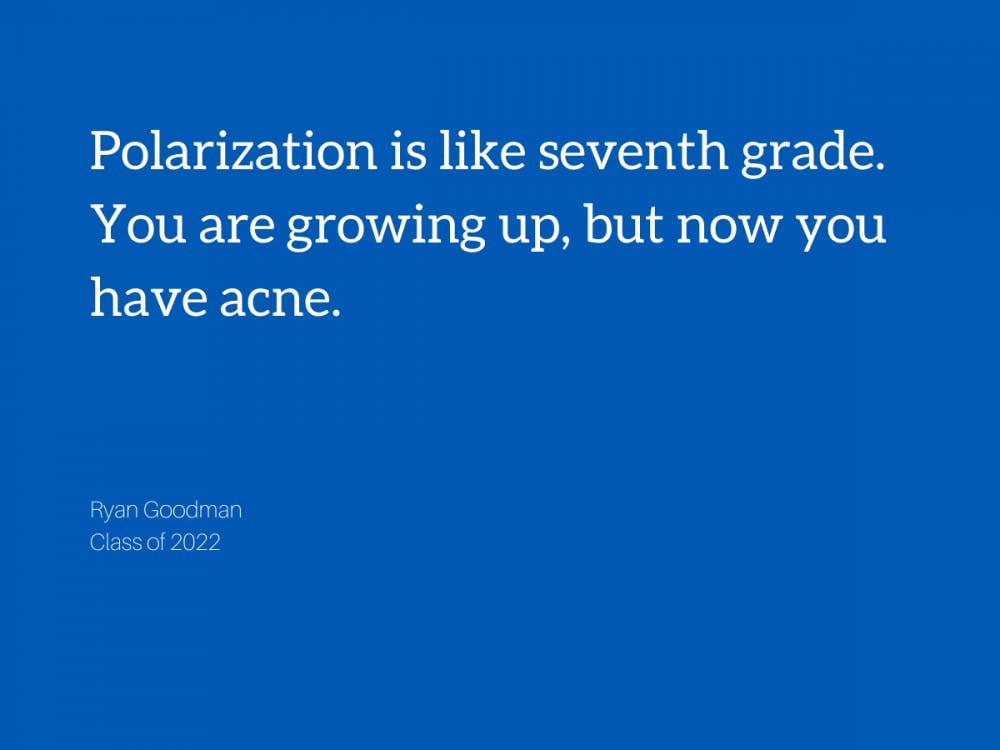If the Chronicle opinion section is any proxy for discussion within the Duke community, it is fair to say that polarization is at the heart of the student body’s political concerns. Political polarization is a popular cause to lament today, and in many respects, it is worth lamenting. Polarization leads to such democratic unpleasantries as incivility, legislative gridlock and a lack of trust in institutions. These unfortunate phenomena have consequences of their own—they test the strength of the democratic experiment. Democracy relies on civility, compromise and trust in institutions, and polarization is eroding those principles.
For those who lament polarization, the data are not pretty. The ideological center of each party has split dramatically since the 1970s. Whereas collaboration between the parties was commonplace in that era, it has since become increasingly rare. The House, the Senate and the electorate have all fled to the ideological poles. Polarization and partisanship go hand in hand—as people become more partisan, they become more ideologically polarized. And as they become more ideologically polarized, they become more partisan. It is a race to the bottom—or more accurately, the poles.
Yet although polarization may appear to be antithetical to American democracy, the two are inseparable. Indeed, the polarization that we see today is a natural byproduct of our democracy. This is democracy’s homeostasis—a state the Founding Fathers envisioned. George Washington may have preached against political parties, but some of the more prescient founders knew that factions would emerge. These factions have never been cleanly organized, but rather have organically formed and morphed throughout the years. As a result, ideology and partisan affiliation were often mismatched, which allowed for significant cooperation across party lines. As the parties continued to evolve, they became more ideologically consistent—a natural and expected process. Since ideology and party have converged, the party centers have diverged, leading to the polarization we see today.
Your father’s conservative ideology did not necessarily mean he was a Republican; your mother’s status as a Democrat did not necessarily mean she was a liberal. It is a modern development in American politics that your ideology defines your party (or in some cases, vice versa). A 1970 study concluded that “there [was] little ideological difference in the following of the two major American political parties.” This same study points out that most Americans back then viewed issues in partisan—rather than ideological—terms. This is a stark contrast from today, where conservative is essentially interchangeable with Republican, and liberal with Democrat.
While it is easy to romanticize the days of relative bipartisan cooperation in the 1970s, that era was just a stepping stool to democracy’s final form (which are still yet to attain). Parties were patchwork compilations based on region, loyalty, and a variety of other non-ideological factors. They were loose coalitions without clear messages or clear differences between them. While this incoherent partisan structure––where a Southern Democrat could have more in common with a Southern Republican than with his own party––produced more bipartisan compromise, was it really a better system? Is that how democracy is supposed to function?
It is not. The purpose of the party system is to provide voters with choices, to allow them to dictate the direction of the nation. Voters are most enabled to control their own destiny when there are clear distinctions between parties. When there is significant overlap in the ideologies of the two parties, voters are left confused and powerless. Conservative ideologue Barry Goldwater recognized that this “bipartisanship” was not how the parties were supposed to function. He argued that the more distinct the parties, the more the voter is offered “a choice, not an echo.” If both parties “echo” each other on policy, then voters do not have a meaningful say. Choice is a democratic ideal, brought to you by polarization.
The alignment of parties with ideology is a natural development. If parties are to be aligned around anything, it only makes sense that they unite around a core set of values and principles. In a world where ideology is the basis for policy, it would be illogical to organize parties around anything other than ideology. James Madison foresaw that the “zeal for different opinions concerning religion, concerning government, and many other points” were the basis of political parties. Now we have reached a point where differing opinions on religion, government, and many other points have indeed become the dividing lines for our political parties. As the Founders intended.
Polarization is like seventh grade. You are growing up, but now you have acne. Your voice starts to squeak. You begin to grow hair in foreign places. Natural processes are not always smooth sailing, and with the good comes the bad. Our democracy is maturing, and polarization is a downside. Incivility, gridlock, and a lack of trust in institutions are democracy’s voice cracks. They are growing pains. If all goes right, America will hit her growth spurt, reckon with the negative downsides, and become a more perfect union.
Ryan Goodman is a Trinity sophomore. His column typically runs on alternate Fridays.
Get The Chronicle straight to your inbox
Signup for our weekly newsletter. Cancel at any time.

